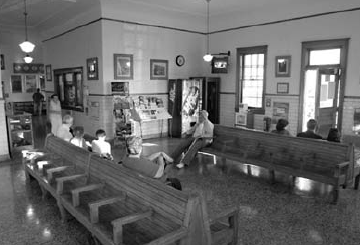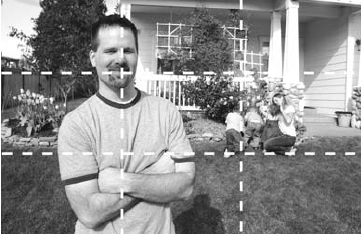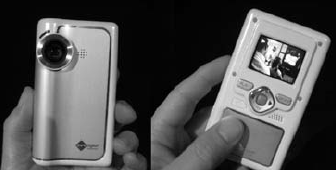Documentary-style video story
The best way to make a solid video story is to think about it the same way you think about writing a story. Indeed, it’s critical to think about how the video will “tell the story.” Once you envision what the story should “say,” it’s simply a matter of filling in the spots with the most appropriate footage. Here’s how.Plan the shoot before you go out: Just like the elements of a good news story that are second nature to you (background, quotes from more than one source, documentation), there are basic elements of a shoot you will need to construct an interesting video story. You need a mix of shots:
- Wide-angle—These shots, also known as “establishing” shots, give viewers a sense of the environment, so shoot the outside of the building or back up and shoot the entire room.
- Medium—Somewhere in between wide and close-up, these shots are the ones you are probably most comfortable shooting.
- Close-ups—These shots zoom in on who’s talking or what they are talking about. Remember: Always zoom first, then record, instead of recording and zooming at the same time.



A good mix would be 25 percent wide-angle, 25 percent close-ups and 50 percent medium or mid-range shots.
Breaking news/highlights/clips style video
For these types of video, you rarely know what the “story” will be in advance. You simply know that news is happening or has happened and you want to capture some essence of it on video.For a breaking news event like a highway crash or a school shooting, you probably won’t get to the scene in time to capture the actual action. However, the reaction from witnesses and investigators as well as footage of the scene are well worth capturing.
Press conferences (if they are tied to compelling news events or delivered by news figures) can make good video and are about the easiest to shoot. You have a fixed subject and the lighting will be good (especially if there are TV cameras around).
Highlights clips, especially in sports, can be among the most popular content on any news site. Shooting sports video can be challenging, however. The constant movement of the subjects requires large capacity in the digital video file and can be hard to follow once the video is downsized and compressed for Web display. As a result, short clips of the best action is the way to go, either edited together with voice-over descriptions or linked to a news story as raw clips with caption information next to the link.
Other important tips to remember:
- Be selective in shooting. There are two good reasons for this: You don’t want to waste tape and you don’t want to waste time editing.
- Avoid panning, zooming. Stop recording when switching between wide, medium and close shots. Avoid zooming and panning if possible. Simply shoot a shot, stop recording, then adjust for the next shot and hit record again.
- Hold your shots. Since you can make a shot shorter in the editing process—but not longer—make sure to hold each of your shots for at least 15 seconds. Even if it’s a wide environment shot that you’ll likely use for 5 seconds, shoot the full 15 seconds. You’ll be glad you did.
- Be silent when you shoot. The camera will pick up every sound you make—a sigh, a cough, a chuckle or anything you say. So keep your lips zipped when recording because you won’t be able to edit out the unwanted audio later.
- Frame your subject carefully. When framing your shot, it is best to avoid a static composition by keeping the main subject slightly off center. To do this consistently, follow the “rule of thirds,” which recommends dividing the frame, using imaginary lines, into thirds both horizontally and vertically. If you position your main subject (usually a face) near one of the intersections of these lines, you will achieve a pleasant, active composition.
- Seek the best short clips. Understand that the best video stories are comprised of many short clips edited together, and your job is to get the best short clips. The best way to fully comprehend the array of clips you need to capture is to actually perform the editing—or at a minimum sit with the person who edits the video. It’s the only way to see what types of clips you shot work best and what types of clips you missed.
 |
As simple as it gets
A company called Pure Digital has released a new line of video cameras that make shooting basic video as easy as recording a conversation on an old microcassette recorder. The device is small and basically “idiot-proof” since it only has buttons for play, record, stop, forward and back. It has to be hand-held and doesn’t zoom, so it’s only appropriate for basic videography, like shooting the subject of a story so the audience can see and hear the person talk and sense their personality. |
“Was this video compelling? Not particularly, but it wasn’t bad. It provided a voice and face to the story, and it offered a multimedia element. It was no worse than what most local TV news stations offer at 6 and 11 p.m. Perhaps of greatest significance, our newsroom embraced this technology in record time: 2.5 hours!”The version of the Pure Digital camera that holds 30 minutes of video sells for $129 at national retailers like Target and Best Buy (as of January 2007). There is also a 60-minute version for $179. “We plan to purchase one or two of these per month throughout the year and deploy them in our bureaus as well as in the newsroom,” Perdue said.
Do a trial run
If you are interested in learning to shoot video, get comfortable before heading out on assignment. Shoot some footage at home of your family or friends and experiment with different types of shots. Practice capturing a mix of shots, using different types of microphones, using a tripod and lighting. Shooting basic video is not difficult but, like most new technology, takes some getting used to.Assignment:
- Watch your favorite local TV news station.
- Try to mimic shots you find effective.
- Compare news stations.
- Look for the rule of thirds.
- Be a critic; it will help you improve.
No comments:
Post a Comment